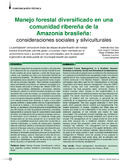| dc.contributor.author | André, da Silva Dias | |
| dc.contributor.author | Campos, José Joaquín | |
| dc.contributor.author | Villalobos Soto, Róger | |
| dc.contributor.author | Louman, Bastiaan | |
| dc.contributor.author | Gonçalvez, Luiza | |
| dc.date.accessioned | 2021-03-04T19:57:58Z | |
| dc.date.available | 2021-03-04T19:57:58Z | |
| dc.date.issued | 2002-04 | |
| dc.identifier.issn | e-ISSN: 1021-0164 | ISSN |
| dc.identifier.uri | https://repositorio.catie.ac.cr/handle/11554/10395 | |
| dc.description | 7 páginas, 5 ilustrado, 1 tabulaciones, 11 referencias. | es_ES |
| dc.description.abstract | Se evaluó la integración de aspectos sociales y silviculturales en el desarrollo de una propuesta de manejo forestal diversificado (madera de varias especies y aceite de Carapa guianensis y de Copaifera sp.) para una comunidad ribereña de la Amazonía brasileña. Se utilizaron diversas herramientas participativas para caracterizar la organización local y la gestión de los recursos naturales. Para entender la percepción sobre la forestería comunitaria, se realizaron encuestas y talleres locales utilizando el enfoque del método FODA (fortalezas, oportunidades, debilidades y amenazas). Además, se elaboró y aplicó un inventario forestal orientado a la implementación de un plan de manejo. Los resultados indican que, debido a la historia de las relaciones, el Gobierno se percibe como una oportunidad pero también como una amenaza para el manejo forestal local. Además, la visión a corto plazo genera conflictos y desacuerdos internos. El aprovechamiento actual de la madera, y de los aceites de Carapa y Copaifera sp. no representa una amenaza para la sostenibilidad del uso del bosque; se trata de prácticas extensivas, orientadas básicamente al consumo local. El conocimiento local puede contribuir a la elaboración de los planes de manejo, pero esta información no es suficiente. La unidad de manejo para Carapa debe ser por área, porque así es la recolecta tradicional y la variabilidad anual de la producción no permite recolectas individuales. La unidad de manejo para Copaifera debe ser individual, debido a la distribución espacial de la especie en el bosque comunal y a la propia naturaleza del aprovechamiento. En la comunidad de Pedreira, hay que fortalecer la dimensión social para promover el manejo diversificado del bosque, pues la clave para el éxito de una propuesta es conciliar las necesidades locales con sus fortalezas y debilidades, sin perder de vista el uso sostenible de los recursos y el desarrollo comunitario. | es_ES |
| dc.description.abstract | Social and silvicultural aspects were considered in the development of a proposal for diversified forest management (timber from several species and oil from Carapa guianensis and Copaifera sp.) within a riverine community in the Brazilian Amazon. Several community participation tools were used for the characterization of the local organization and natural resource management. Using the SWOT method, surveys and local workshops were organized to understand the local perception about community forestry. A forestry inventory which focused on the implementation of a management plan for the selected products was also designed and applied. The results show that the Government, because of the history of relations with the community, is perceived by the community as an opportunity and as threat to promote the local forest management. They also suggest weakness in short term goals, which generate internal conflicts and disagreements. The present exploitation of Carapa, Copaifera and timber does not present any threat on the sustainability of the forest, as they are extensive practices, of low intensity and mainly for local consumption. The contribution of local knowledge may contribute in the planning and design of the forest workplans, but it alone is not enough. The management unit for Carapa should be done at the area level, because this is traditional collection method and because annual tree production varies and does not allow for individual tree collection. The management unit for Copaifera should be at the tree level because of the spatial distribution within the community and the collection methods. Special attention must be given to the social context in order to promote diversified forest management in Pedreira, since the success of any proposal is based on addressing local needs along with its strengths and weakness without compromising the objective of sustainable use of resources and community development. | |
| dc.language.iso | es | es_ES |
| dc.publisher | Centro Agronómico Tropical de Investigación y Enseñanza (CATIE), Turrialba (Costa Rica) | es_ES |
| dc.relation.ispartof | Revista Forestal Centroamericana Número 38 (abril-junio 2002), páginas 78-84 | |
| dc.rights | info:eu-repo/semantics/openAccess | |
| dc.subject | AMAZONAS (BRASIL) | es_ES |
| dc.subject | CAMBIO SOCIAL | es_ES |
| dc.subject | COMUNIDADES RURALES | es_ES |
| dc.subject | DESAROLLO COMUNAL | es_ES |
| dc.subject | GESTION AMBIENTAL | es_ES |
| dc.subject | INVENTARIOS FORESTALES | es_ES |
| dc.subject | ORDENACION FORESTAL | es_ES |
| dc.subject | PLANIFICACION | es_ES |
| dc.subject | RECURSOS NATURALES | es_ES |
| dc.subject | SILVICULTURA | es_ES |
| dc.title | Manejo forestal diversificado en una comunidad ribereña de la Amazonía brasileña: consideraciones sociales y silviculturales | es_ES |
| dc.title.alternative | Diversified forest management in a brazilian Amazon riverside community: social and silvicultural considerations | es_ES |
| dc.type | Artículo | es_ES |


